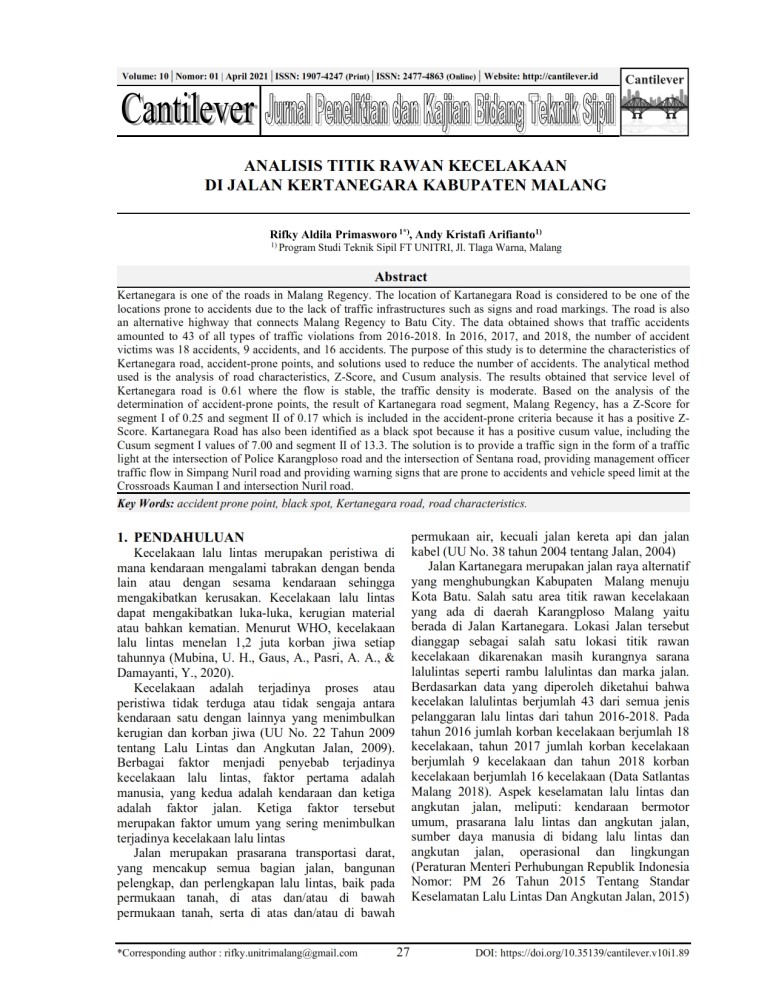Analisis Titik Rawan Kecelakaan di Jalan Kertanegara Kabupaten Malang Analysis of Accident-Prone Points on Kertanegara Road of Malang Regency
Main Article Content
Abstract
Kertanegara is one of the roads in Malang Regency. The location of Kartanegara Road is considered to be one of the locations prone to accidents due to the lack of traffic infrastructures such as signs and road markings. The road is also an alternative highway that connects Malang Regency to Batu City. The data obtained shows that traffic accidents amounted to 43 of all types of traffic violations from 2016-2018. In 2016, 2017, and 2018, the number of accident victims was 18 accidents, 9 accidents, and 16 accidents. The purpose of this study is to determine the characteristics of Kertanegara road, accident-prone points, and solutions used to reduce the number of accidents. The analytical method used is the analysis of road characteristics, Z-Score, and Cusum analysis. The results obtained that service level of Kertanegara road is 0.61 where the flow is stable, the traffic density is moderate. Based on the analysis of the determination of accident-prone points, the result of Kartanegara road segment, Malang Regency, has a Z-Score for segment I of 0.25 and segment II of 0.17 which is included in the accident-prone criteria because it has a positive Z-Score. Kartanegara Road has also been identified as a black spot because it has a positive cusum value, including the Cusum segment I values of 7.00 and segment II of 13.3. The solution is to provide a traffic sign in the form of a traffic light at the intersection of Police Karangploso road and the intersection of Sentana road, providing management officer traffic flow in Simpang Nuril road and providing warning signs that are prone to accidents and vehicle speed limit at the Crossroads Kauman I and intersection Nuril road.
Downloads
Article Details
Austroads road engineering guides 2009. (2009). Australia: The NZ Transport Agency.
Mubina, U. H., Gaus, A., Pasri, A. A., & Damayanti, Y. (2020). Uji laik fungsi jalan dalam mewujudkan jalan yang berkeselamatan studi kasus jalan utama Kota Weda. Journal of Science and Engineering, 17-24.
Peraturan Daerah Kabupaten Malang Nomor 3 Tahun 2010 tentang Rencana Tata Ruang Wilayah Kabupaten Malang. (2010). Malang: Pemerintah Kabupaten Malang.
Peraturan Direktur Jenderal Perhubungan Darat No. SK.7234/AJ.401/DRJD/2013 tentang Petunjuk Teknis Perlengkapan Jalan. (2013). Jakarta: Direktur Jenderal Perhubungan Darat.
Peraturan Menteri Perhubungan Republik Indonesia Nomor PM 49 Tahun 2014 tentang Alat Pemberi Isyarat Lalu Lintas. (2014). Jakarta: Kementrian Perhubungan.
Peraturan Menteri Perhubungan Republik Indonesia Nomor: PM 26 Tahun 2015 Tentang Standar Keselamatan Lalu Lintas Dan Angkutan Jalan. (2015). Jakarta: Kementrian Perhubungan.
Peraturan Direktur Jenderal Perhubungan Darat Nomor: SK.2574/AJ.403/DRJD/2017. (2017). Jakarta: Direktur Jenderal Perhubungan Darat.
Setiawati, D. N., Intari, D. E., & Zailani, A. . (2019). Analisis titik rawan kecelakaan lalu lintas pada ruas jalan provinsi (Studi kasus: Jl. Raya Legok dan Jl. Raya Kelapa Dua Kab. Tangerang). Jurnal Kajian Teknik Sipil, 4(1) , 76-86.
Sugiyono. (2007). Metode Penelitian Kuantitatif Kualitatif dan R&D, 10th ed. Bandung: Alfabeta.
UU No. 38 tahun 2004 tentang Jalan. (2004). Jakarta: Sekretariat Negara.
UU No. 22 Tahun 2009 tentang Lalu Lintas dan Angkutan Jalan. (2009). Jakarta: Kementerian Perhubungan.
Warpani, S. P. (2002). Pengelolaan Lalu Lintas dan Angkutan Jalan, 2nd ed. Bandung: Penerbit ITB.

This work is licensed under a Creative Commons Attribution-NonCommercial 4.0 International License.
Authors who publish with this journal agree to the following terms:
- Authors retain copyright and grant the journal right of first publication with the work simultaneously licensed under a Creative Commons Attribution-NonCommercial 4.0 International License that allows others to share the work with an acknowledgment of the work's authorship and initial publication in this journal.
- Authors are able to enter into separate, additional contractual arrangements for the non-exclusive distribution of the journal's published version of the work (e.g., post it to an institutional repository or publish it in a book), with an acknowledgment of its initial publication in this journal.
- Authors are permitted and encouraged to post their work online (e.g., in institutional repositories or on their website) prior to and during the submission process, as it can lead to productive exchanges, as well as earlier and greater citation of published work (See The Effect of Open Access).
